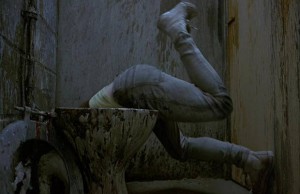I like what is mentioned in The Theory Toolbox text book, “We tend to understand interpretation or reading as a metaphoric process, which is to say, we understand interpretation as allegorical rather than literal” (30). I read this as a statement saying we are programmed to communicate in metaphor. It reminds me of the film Trainspotting. It is a sarcastic comedy about addiction. The plot follows the lives of several substance abusers, their misadventures, struggles to break away from the ailment, and conflicting interests they share with one another. In the first few minutes of the film, the main character, Mark Renton, tries to detox himself using a method his friend Sick Boy developed. It involves a few random objects, such as buckets for urination and vomiting, ice cream, soup, and a bottle of Valium. The final ingredient is a dose of heroin. This is supposed to soothe the withdrawal symptoms before the Valium takes effect.
Renton, goes to visit his usual drug supplier who is out of heroin but gives him a Morphine suppository. While Renton is walking home, he feels his bowels move. He mentions one of the side effects to addiction is constipation, and seeing as he is weening away from drugs, he is in tremendous need of a relief. Going into a local pub, Renton finds a restoom with the caption “Worst in Scotland,” appearing. The state of cleanliness is repulsive to say the least. He is hesitant to sit on the toilet until his bowels move again. With no choice, he sits and relives himself. Once Renton realizes he lost the morphine, he wastes no time in searching threw the horrendous toilet. After rummaging through the toilet, he proceeds to dive inside, submerging himself through the septic tank. As soon as he finds the Morphine, he exclaims in joy.
I read this scene behaving as a metaphor in two ways. One, Renton, as a drug addict, has hit such a low point in his life it has become “shit.” It is relating the idea of fecal matter in a toilet, to drug addiction as a “shitty” life. Two, the image of desperately searching through a toilet, that otherwise he was reluctant to sit on, shows a metaphor for how far the addict will go for the next “fix.” Bearing in mind, upon entering the bathroom, there is not a single word of spoken dialogue. The reading or dialogue the audience follows is the actor’s (Ewan Mcgregor’s) mannerisms. He dry heaves, and turns away from the toilet, so as not to possibly vomit in the toilet. If human communication has such a huge emphasis on metaphor, then we need to be able to isolate it, especially when we are outside of the mainstream English classroom. We are accustomed to examining metaphor there, because it is the norm, but where are moments of metaphorical speech outside of it? How can metaphor truly function? I feel this scene helps bring that to light. Metaphor does not have to be reserved to the analysis of poems, literature, and things of that nature, but can be seen in other forms of communication. In this sense, a brief scene from a film.


This scene certainly bears out Nealon and Giroux’s point that “even abstract ideas are constructed out of concrete signifiers”! Your reading of this scene takes the metaphorical leap–“a drug addicts life is exceedingly dismal–and brought it back to the concrete material signifiers, back to that words toilet in Scotland. So your right that we need to attend to these metaphors, but more importantly, we need to attend to how these metaphors make meaning.
A note on the post: use links (you could link to the IMDB page for Trainspotting for example), video (can you find this scene on Youtube?) when relevant. The images are great, but you place them at the very end. It’s easy to blend them in around the text. Also, no need to refer to “Theory Toolbox” as a textbook–that might seem odd to an outside reader.